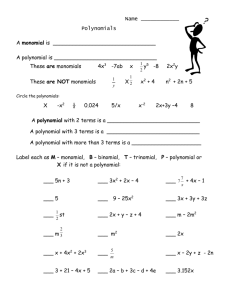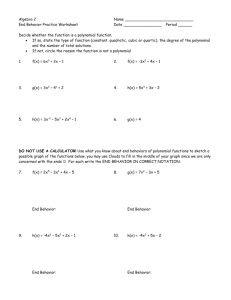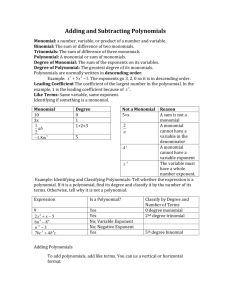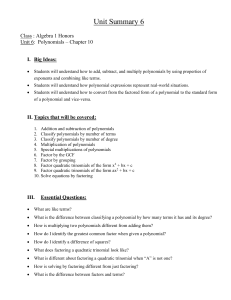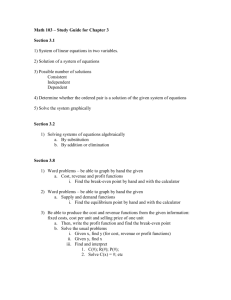5.2 Polynomials and Polynomial Functions
advertisement
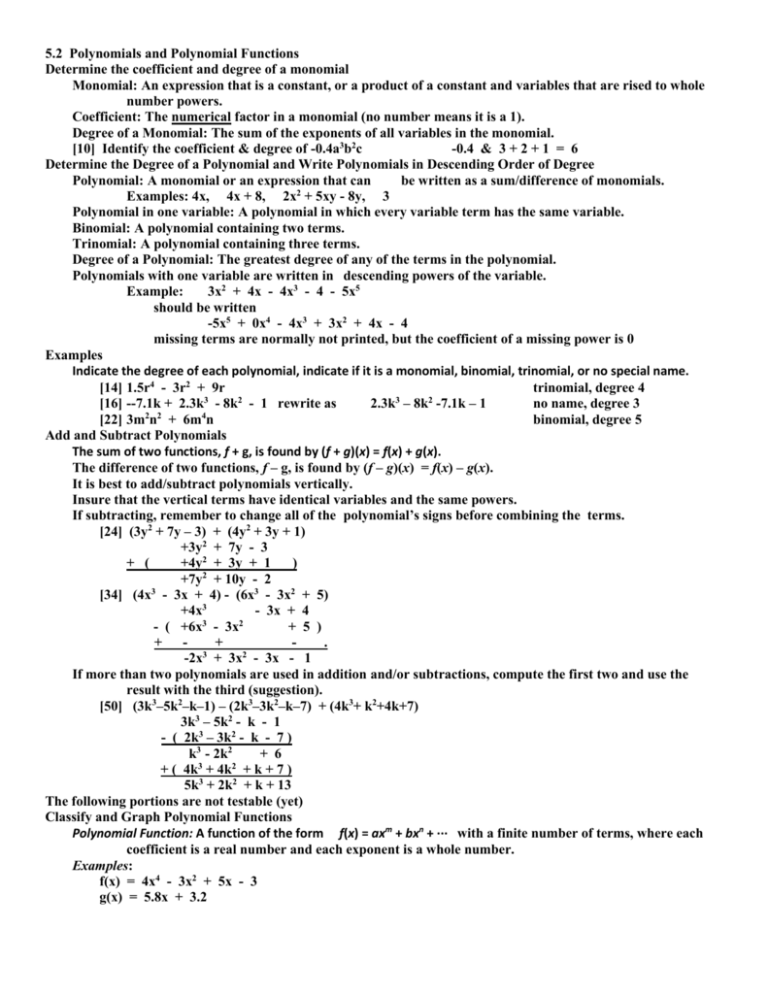
5.2 Polynomials and Polynomial Functions Determine the coefficient and degree of a monomial Monomial: An expression that is a constant, or a product of a constant and variables that are rised to whole number powers. Coefficient: The numerical factor in a monomial (no number means it is a 1). Degree of a Monomial: The sum of the exponents of all variables in the monomial. [10] Identify the coefficient & degree of -0.4a3b2c -0.4 & 3 + 2 + 1 = 6 Determine the Degree of a Polynomial and Write Polynomials in Descending Order of Degree Polynomial: A monomial or an expression that can be written as a sum/difference of monomials. 2 Examples: 4x, 4x + 8, 2x + 5xy - 8y, 3 Polynomial in one variable: A polynomial in which every variable term has the same variable. Binomial: A polynomial containing two terms. Trinomial: A polynomial containing three terms. Degree of a Polynomial: The greatest degree of any of the terms in the polynomial. Polynomials with one variable are written in descending powers of the variable. Example: 3x2 + 4x - 4x3 - 4 - 5x5 should be written -5x5 + 0x4 - 4x3 + 3x2 + 4x - 4 missing terms are normally not printed, but the coefficient of a missing power is 0 Examples Indicate the degree of each polynomial, indicate if it is a monomial, binomial, trinomial, or no special name. [14] 1.5r4 - 3r2 + 9r trinomial, degree 4 [16] --7.1k + 2.3k3 - 8k2 - 1 rewrite as 2.3k3 – 8k2 -7.1k – 1 no name, degree 3 [22] 3m2n2 + 6m4n binomial, degree 5 Add and Subtract Polynomials The sum of two functions, f + g, is found by (f + g)(x) = f(x) + g(x). The difference of two functions, f – g, is found by (f – g)(x) = f(x) – g(x). It is best to add/subtract polynomials vertically. Insure that the vertical terms have identical variables and the same powers. If subtracting, remember to change all of the polynomial’s signs before combining the terms. [24] (3y2 + 7y – 3) + (4y2 + 3y + 1) +3y2 + 7y - 3 + ( +4y2 + 3y + 1 ) +7y2 + 10y - 2 [34] (4x3 - 3x + 4) - (6x3 - 3x2 + 5) +4x3 - 3x + 4 - ( +6x3 - 3x2 + 5 ) + + . 3 2 -2x + 3x - 3x - 1 If more than two polynomials are used in addition and/or subtractions, compute the first two and use the result with the third (suggestion). [50] (3k3–5k2–k–1) – (2k3–3k2–k–7) + (4k3+ k2+4k+7) 3k3 – 5k2 - k - 1 - ( 2k3 – 3k2 - k - 7 ) k3 - 2k2 + 6 + ( 4k3 + 4k2 + k + 7 ) 5k3 + 2k2 + k + 13 The following portions are not testable (yet) Classify and Graph Polynomial Functions Polynomial Function: A function of the form f(x) = axm + bxn + ··· with a finite number of terms, where each coefficient is a real number and each exponent is a whole number. Examples: f(x) = 4x4 - 3x2 + 5x - 3 g(x) = 5.8x + 3.2 Constant Function: A function of the form f(x) = c where c is a real number. The graph of a constant function is a horizontal line through (0, c). Example: y f(x)=2 x -5 -4 -3 -2 -1 1 2 3 4 5 f(x) = -2 Linear Function: A function of the form f(x) = mx + b where m and b are real numbers. Graphs of linear functions are lines with slope m and y-intercept (0, b). Example f(x) = 2x – 1 y f(x)=2x-1 x -5 -4 -3 -2 -1 1 2 3 4 5 m=2 y-int = (0,-1) Quadratic Function: A function of the form f(x) = ax2 + bx + c where a, b, and c are real numbers and a ≠ 0. Graphs of quadratic functions are parabolas with y-intercept at (0, c). Examples: ______________________ f(x) = 2x2 + 3x – 5 2 g(x) = -3x + 2x + 6 - - - - - - - - y f(x)=2x^2+3x-5 f(x)=-3x^2+2x+6 x -11 -10 -9 -8 -7 -6 -5 -4 -3 -2 -1 1 2 3 4 5 6 7 8 9 10 11 Cubic Function: A function of the form f(x) = ax3 + bx2 + cx + d where a, b, c, and d are real numbers and a ≠ 0. Graphs of cubic functions resemble an S-shape with y-intercept at (0, d). Examples: f(x) = 2x3 - 5x2 + 3x + 5 g(x) = -x3 - 2x2 + 4x + 5 y f(x)=2x^3-5x^2+3x+5 f(x)=-x^3-2x^2+4x+5 x -11 -10 -9 -8 -7 -6 -5 -4 -3 -2 -1 1 2 3 4 5 6 7 8 9 10 11
